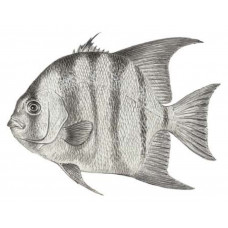Latin name
Chaetodipterus faber
Other names
Enxada, paguara.
Identification
Their body is very flattened and almost as deep as it is long. The first, or barbed, dorsal fin is separated from the second, or soft-beam, dorsal fin, which has exceptionally long rays at the front and corresponds in size and shape to the anal fin immediately below it. The body is silvery with four to six black stripes, which may be absent in older fish. The broad caudal fin has long rays at the ends of the upper and lower lobes, so the fin is concave. The mouth is small. Young fish are black and have been known to lie on their sides, imitating floating debris.
Distribution
Species found in North American waters and occasionally caught by anglers include the Pacific spadefish (Chaetodipterus zonatus), which lives from Southern California to Mexico in the eastern Pacific, and the similar Atlantic spadefish (C. faber), which lives from Massachusetts to Brazil in the western Atlantic Ocean and is more numerous in the Caribbean and Florida.
Habitat
Spadefish are mostly tropical and subtropical species. The fish are found on the shore or in the coastal area, especially around navigational signs, along sandy beaches, in harbors or over shipwrecks.
Size
Can grow up to 15 pounds, but usually weigh less than 2 pounds.
Life history and Behavior
Spadefish move in large schools, spawning in spring and summer.
Food and feeding habits
Spadefish feed on shrimp and crustaceans.
Reproduction
No information
| Classification | |
| Phylum | Chordata |
| Class | Actinopterygii |
| Squad | Acanthuriformes |
| Family | Ephippidae |
| Genus | Chaetodipterus |
| Species | C. faber |
| Features | |
| Conservation status | Least Concern |
| Habitat | Pelagic |
| Life span, years | No information |
| Maximum body weight, kg | 9.1 |
| Maximum length, cm | 91 |
| Sailing speed, m/s | No information |
| Threat to people | Edible |
| Way of eating | Predator |




